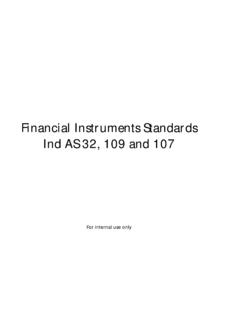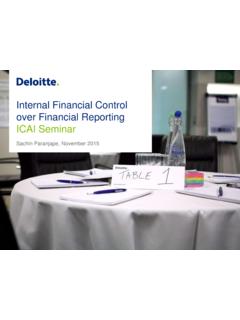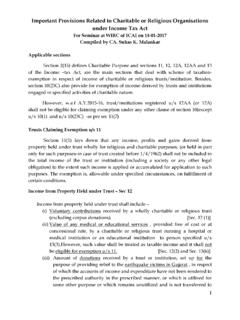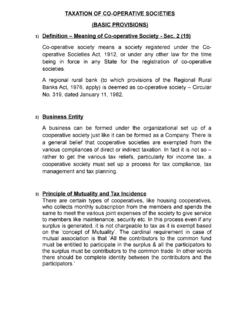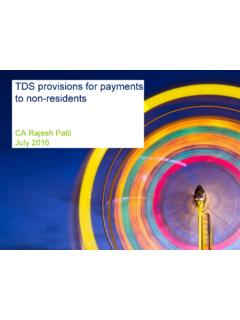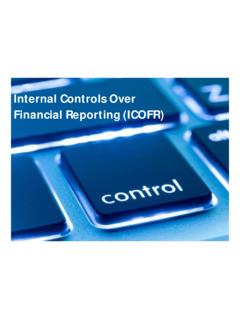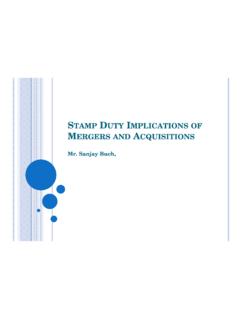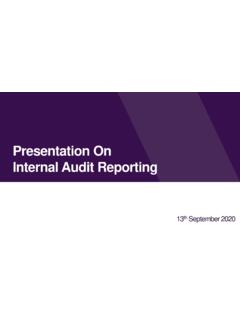Transcription of IMPORTANT PROVISIONS OF STAMP DUTY AND …
1 IMPORTANT PROVISIONS OF BOMBAY STAMP ACT, INDIAN STAMP ACT & REGISTRATION ACT. - CA VIMAL PUNMIYA STAMP DUTY INTRODUCTION: The Bombay STAMP Act, 1958 came into force on 16th Feb, 1959 and is applicable in the State of Maharashtra. The Act is intended to levy STAMP duty on certain types of documents executed in the state or brought from outside for acting upon the same in the state. The various instruments/documents are broadly covered under different 62 articles listed in Schedule-I appended to the Act. The rates at which STAMP duty is levied on these documents are mentioned in Schedule I. The Bombay STAMP Act levies STAMP duty on documents or instruments by which any right or liability is, or purports to be created, transferred, limited, extended, extinguished or recorded. What is STAMP Duty? It is a type of tax which is paid to the State Government for the transaction performed by way of document or instrument under the PROVISIONS of Bombay STAMP Act, 1958 and Indian STAMP Act, 1899.
2 Whether STAMP Duty is payable on instruments or on transactions? STAMP Duty is payable on instruments/documents and not on transactions: STAMP duty is charged on the basis of the contents of the documents only. Any information which is vital for the purpose of working out the STAMP duty must be duly mentioned in the document/instrument. If such information is missing, the STAMP Duty Valuation Officer can ask for the same. For eg. Incase of an instrument for transfer of property, several IMPORTANT details such as carpet area or built up area of the property, number of floors in the building, year of construction, name of the division/village, number of plot of land etc are necessary and required to be mentioned in the agreement. What is an Instrument? The definition of the term instrument is very wide. Instrument means any document by which any right or liability is, or purports to be created, transferred, limited, extended, extinguished or recorded.
3 What is a Document? As defined in Evidence Act, a document means only matter expressed or described upon substance by means of letters, figures or marks or by more than any of those means intended to be used or which may be used for the purpose of recording that matter. Why is it IMPORTANT to pay STAMP duty on instruments/ documents? The payment of proper STAMP duty on instruments bestows legality on them; such instruments get evidentiary and are admitted as evidence in court of law. The instruments which are not properly stamped are not admitted in evidence by the court. What is meant by execution of instruments? Execution of instruments means putting signatures on the instruments by the person or persons who are the parties to the transaction which is being performed through such instruments. Thus, when the respective parties signs the instrument the instrument is said to have been executed. Which are the instruments that attract STAMP duty under the Bombay STAMP Act?
4 There are 63 types of instruments which attract STAMP duty under Bombay STAMP Act, 1958. Some of the IMPORTANT and foremost instruments under the Bombay STAMP Act, 1958 are :- a) Agreements; b) Conveyances; c) Exchange; d) Gifts; e) Certificate of Sale; f) Deed of Partition ; g) Power of Attorney to sell immovable property when given for consideration ; h) Deed of settlement ; i) Lease by way of Assignment. Which are the instruments that attract STAMP duty under the articles of the Indian STAMP Act, 1899 in the State of Maharashtra? The following instruments under the Articles of Indian STAMP Act, 1899 attracts STAMP duty in the State of Maharashtra. Article No. Instruments 13 Bill of Exchange 14 Bill of lading 27 Debenture 37 Letter of Credit 47 Policy of Insurance 49 Promissory Notes 52 Proxy 53 Receipt 62 Transfer It is to be noted that the Revenue received under the Indian STAMP Act, 1899 goes to the Central Government. What is the relevance of the dates ad relates to arrival of market value concept.
5 From , on conveyance, the purchaser is required to pay STAMP duty on the market value of the immoveable property transferred as per article 25(b), at the time of execution of the conveyance. Whereas, prior to , there was no market value concept and agreement value was accepted for STAMP duty payment. relates to the arrival of deemed conveyance concept. From , even on agreement for sale, the purchaser is required to pay STAMP duty on the market value of the immoveable property transferred as a deemed conveyance due to explanation appended to Article 25(d), at the time of signing the agreement for sale itself. Whereas, prior to , such agreement for sale required a STAMP of only, at the time of signing the agreement under Article 5(h) provided STAMP duty as applicable to conveyance will be payable at the time of conveyance of the immoveable property in future. Who is liable to pay STAMP duty? Liability for the payment is indicated in Sec.
6 30 of the Bombay STAMP Act 1958. In the absence of an agreement to the contrary, STAMP duty shall be paid by the purchaser. In case of lease or Agreement to lease, the STAMP duty has to be paid by the lessee. In the case of instrument of exchange it is to be paid by the parties in equal share. Insertion of Section 30A in the Maharashtra STAMP Act. After Section 30 of the Maharashtra STAMP Act, a new section Section 30A has been inserted. Section 30A states the STAMP duties payable by financial institutions. It provides that notwithstanding anything contained in Section 30, where any instrument referred to in clause (a) to (g) of Section 30, is executed on or after the date of commencement of the Maharashtra Tax Law (Levy and Amendment) Act, 2013, in favour of or by any financial institution such as bank, non-banking financial company, housing finance company or alike, which creates any right in favour of any such financial institution, the liability to pay proper STAMP duty shall be on such financial institution concerned without affecting their right, if any, to collect it from the other party.
7 In case any such instrument is executed before the date of commencement of the Maharashtra Tax Laws (Levy and Amendment) Act, 2013 and is effective and where proper STAMP duty is not paid, then the financial institution shall impound the instrument on or before the and forward the same to the Collector. If the financial institution fails to impound such instrument, then the concerned financial institution shall be liable to pay a penalty equal to the STAMP duty payable on such an instrument. When is STAMP duty payable? The STAMP duty is payable on instruments before or at the time of execution or on the next working day following the day of execution. However, it is our practical experience that with a view to avoid harassment, one should pay STAMP duty as far as possible before executing the agreement. How is STAMP duty payable (mode of payment of STAMP duty)? The STAMP duty can be paid by account payee cheque, demand draft or pay order.
8 If it is paid by cheque, the documents are delivered after the encashment of the cheque. In case the STAMP duty has been paid by pay order, or demand draft the documents are returned within a short period of time. If the amount of the STAMP duty is above ,000/- and one wishes to pay by cash, then the amount will have to be deposited in Reserve Bank of India and/or any other specified Bank and the challan to the effect will have to be submitted to the office of the Superintendent of Stamps. In whose names are the stamps required to be purchased? From , the stamps are required to be purchased in the name of the one of the executors to the instrument. If the instrument is executed on the stamps which do not bear the name of one of the executors, then such instruments will not be admitted as evidence for any purpose. These instruments will also be treated as not properly stamped. Further such instruments will be liable to be impounded by any Govt or Semi Govt office or court and sent to the Collector of Stamps for recovery of proper STAMP duty.
9 What happens if the instrument is executed on stamps which do not bear the name of one of the executors? Such instruments are not admitted in evidence, for any purpose. These instruments are also treated as not properly stamped. These instruments therefore cannot be registered under the Registration Act. These instruments are liable to be impounded and sent to the Collector of Stamps for recovery of proper STAMP duty. METHOD AND MECHANISM What is meant by adjudication of instruments? Sec. 31 of the Bombay STAMP Act, 1958 deals with the adjudication of the instruments. Adjudication means determining the chargeability of stamps appointed in each district. In respect of the transfer of the Immovable property, adjudication means determining the amount of STAMP duty payable on such transfer. What is the procedure for adjudication of instruments? As per Sec 31, the parties are required to file the Original instrument ( signed or unsigned ) with the STAMP duty officials and pay the prescribed fee of as adjudication fees.
10 The application has to be submitted to the authorities along with: (i) Original instruments with one xerox copy (ii) Information in Form II of the Bombay STAMP determination of true market value of the property Rules 1981 in the form of affidavit on a STAMP paper of Rs. Nil duly notarized. What remedy is available to the parties, in case they do not agree with the true market value of the property as determined by Collector of the District? Appeal against adjudication: The chargeability of STAMP duty on the instrument as determined by the Collector of Stamps in Adjudication is not final. The person affected by the order of the Collector of Stamps can go in appeal to the Chief controlling Revenue Authority as provided in Sec. 53 of the Bombay STAMP Act 1958. Though there is no time limit prescribed for the filing of an appeal, it will be desirable to file the appeal at the earliest to avoid complications.
